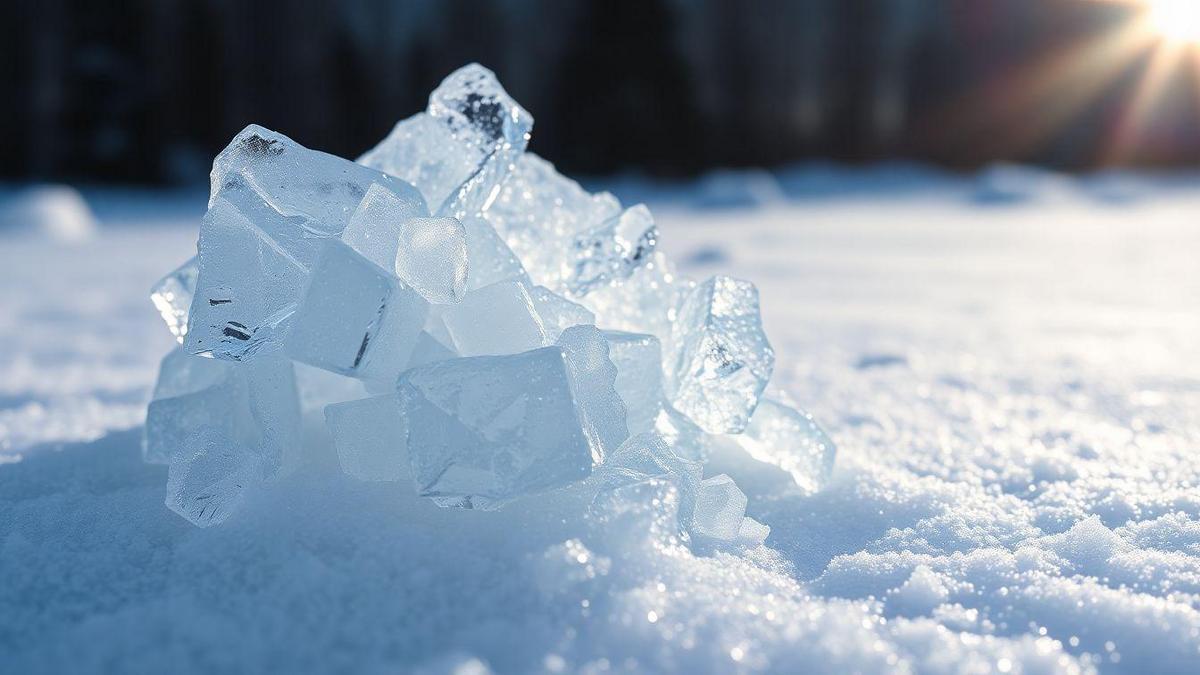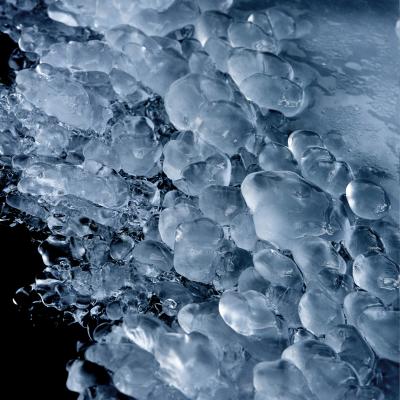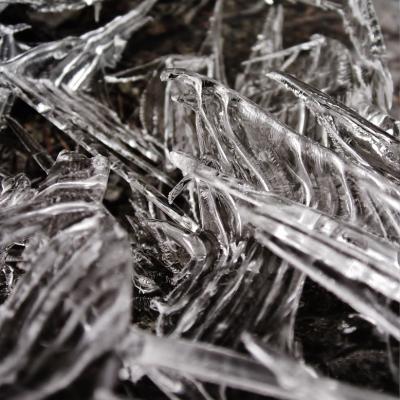Anúncios
Ice crystals are natural wonders that capture attention with their beauty and perfect symmetry. They form when water vapor in the atmosphere freezes at low temperatures, creating intricate geometric patterns. This natural process, governed by the molecular structure of water, reveals an incredible mathematical harmony.
Studying the formation of these crystals not only helps us understand meteorological phenomena but also has implications for various fields such as materials science and art. The symmetry and geometric patterns of ice crystals have inspired scientists and artists for centuries, leading to new discoveries and innovations. The mathematical beauty hidden behind these crystals is a true expression of nature’s perfection.
Anúncios

How Ice Crystal Formation Works
The formation of ice crystals begins with nucleation, when small water molecules cluster together, creating the base of the crystal. This process occurs when temperature and humidity conditions are ideal, usually in environments with below-freezing temperatures. As water turns into ice, it arranges its molecules in a highly structured way, forming symmetrical geometric patterns.
The symmetry of ice crystals arises from the hexagonal arrangement of water molecules. Each molecule forms hydrogen bonds with its neighbors, creating a six-sided pattern. This process is governed by intermolecular forces, which favor the creation of organized and repetitive structures.
Although the basic structure is hexagonal, crystals can take on varied shapes such as plates and dendrites. The speed at which the crystal forms and the environmental conditions directly influence the final pattern. In high-humidity environments, the crystals tend to be larger and more complex, while in dry places, they are simpler.
These crystals grow as more water molecules attach to their initial structure. The balance between temperature, humidity, and atmospheric pressure defines the exact characteristics of each crystal. This balance is essential for studying ice crystals and how their geometric shapes can be predicted.
The Importance of Mathematical Patterns in Ice Crystals
Ice crystals display perfect mathematical patterns, a direct result of the physical and chemical properties of water. The hexagonal symmetry is one of the most impressive features and is a reflection of the geometry underlying crystal formation. These patterns can be mathematically modeled, allowing for a deeper understanding of how and why they form in this way.
The mathematics governing the formation of ice crystals is related to the theory of symmetries and crystal lattices. The arrangement of water molecules in a hexagonal lattice follows geometric principles that can be described by precise equations. This study of symmetry and geometry has applications in various fields of science and technology.
Scientists use this information to model the behavior of crystals under different conditions. The study of ice crystals, for example, has been fundamental in understanding other substances and materials that exhibit similar properties, such as certain metals and crystals. Furthermore, the mathematics behind these patterns inspires the design of new materials and technologies.
The mathematical beauty of ice crystals also serves as inspiration for fields such as art and architecture. Designers and artists seek the symmetry and patterns found in nature to create visually striking works and structures. This shows how the mathematical patterns of ice crystals not only have scientific value but also aesthetic and creative appeal.
Environmental Conditions and the Growth of Ice Crystals

Temperature and humidity are crucial factors in the growth and shape of ice crystals. In environments with extremely low temperatures and high humidity, crystals grow faster and take on complex forms. This happens because as water changes from gas to solid, more molecules are available to bond, forming more elaborate structures.
When humidity is low, crystals tend to be simpler, with more regular and less branched shapes. The cooling rate also influences the final shape of the crystal, with rapid cooling resulting in thin crystals and slow cooling generating wider, more structured forms. These combined factors determine the final appearance of ice crystals.
Observing these variations in the shapes of ice crystals can provide important information about the climate and atmospheric conditions of a given region. Meteorologists can use this information to predict weather changes, such as snowstorms or temperature shifts. The study of conditions that favor different patterns also helps understand phenomena like snow and ice formation.
Moreover, variations in ice crystal growth are fundamental to research in materials science. The analysis of different crystal shapes can inspire new materials with specific properties, such as greater impact resistance or better thermal conductivity. This demonstrates the interconnection between nature and technological innovation.
Advantages of Understanding the Formation of Ice Crystals and Their Perfect Mathematical Patterns
Understanding the formation of ice crystals and their perfect mathematical patterns offers several advantages across multiple disciplines. First and foremost, it enhances our understanding of meteorological phenomena. By studying the conditions under which different forms of ice crystals develop, meteorologists can improve weather forecasts and gain insights into atmospheric processes. This knowledge is crucial for predicting snowstorms, understanding climate change, and anticipating ice behavior in polar regions.
In addition to its applications in meteorology, knowledge about the formation of ice crystals has significant implications for materials science. Researchers can draw parallels between the structures of ice crystals and the properties of other materials. For example, the hexagonal lattice structure of ice can provide insights into the behavior of certain metals and crystals. By understanding how different conditions affect the growth and structure of ice crystals, scientists can develop new materials with desired properties, such as increased strength or better thermal conductivity.
Another advantage of studying ice crystals lies in their aesthetic and artistic value. The intricate patterns and symmetrical designs found in ice crystals have inspired artists and designers for centuries. By understanding the mathematics behind these patterns, artists can create works that reflect the beauty of nature’s designs. Moreover, this knowledge can be applied in areas such as architecture, where principles of symmetry and structure are essential to creating visually appealing and functional designs.
Finally, studying the formation of ice crystals promotes a deeper appreciation for the natural world. By exploring the science behind these seemingly simple structures, individuals can gain a greater understanding of the interconnectedness of natural processes. This appreciation can lead to increased awareness of environmental issues and a desire to protect the delicate ecosystems where ice crystals form. Ultimately, understanding the formation of ice crystals and their perfect mathematical patterns enriches our knowledge of the world around us and inspires innovation across various fields.
How to Observe the Formation of Ice Crystals and Their Perfect Mathematical Patterns

Observing the formation of ice crystals and their perfect mathematical patterns can be a rewarding endeavor for both scientists and enthusiasts. To start, it is essential to choose the right conditions for observation. Cold and clear winter days are ideal for observing ice crystals, as the low temperatures and low humidity levels create the perfect environment for their formation. When the temperature is around -10 to -20 degrees Celsius, the likelihood of witnessing beautiful ice crystals increases significantly.
Once the right conditions are set, one can begin observing the ice crystals using a simple microscope or magnifying glass. This equipment allows for a more detailed analysis of the crystals’ intricate details. When snowflakes fall, they often land on surfaces like grass, leaves, or cold windows. By carefully collecting snowflakes and placing them on a dark surface, observers can capture the beauty of their patterns. It is crucial to handle the snowflakes gently, as they can easily melt or break.
Taking photographs of ice crystals can also enhance the observation experience. Using a camera with a macro lens, enthusiasts can capture the stunning details of individual snowflakes. This process requires patience and a steady hand, as the delicate structures can be easily disturbed. Photographers can experiment with different lighting conditions to highlight the unique shapes and patterns of the crystals. The resulting images can serve as a beautiful reminder of the intricate beauty found in nature.
In addition to direct observation, it is also possible to study the formation of ice crystals in controlled environments. Creating a frost chamber or using a cold box can provide a controlled setting for observing the growth of ice crystals. By adjusting factors such as temperature, humidity, and airflow, researchers can manipulate the conditions to study how different variables affect ice crystal formation. This approach allows for a deeper understanding of the processes involved in ice crystal formation and can lead to exciting discoveries.
In conclusion, observing the formation of ice crystals and their perfect mathematical patterns requires careful planning and attention to detail. By choosing the right conditions, using appropriate tools, and capturing the beauty of these structures through photography, enthusiasts can gain a greater appreciation for the intricate designs found in nature. Whether through direct observation or controlled experiments, the study of ice crystals offers a fascinating glimpse into the world of natural phenomena.
Did You Enjoy Learning About the Formation of Ice Crystals and Their Perfect Mathematical Patterns?
Learning about the formation of ice crystals and their perfect mathematical patterns is a captivating journey into the art of nature. The intricate designs and symmetrical shapes found in ice crystals reveal the underlying principles of chemistry and physics, showcasing the beauty of the natural world. This exploration not only enhances our understanding of meteorological phenomena but also inspires creativity across various fields, from art to materials science.
As you delve deeper into the study of ice crystals, you may discover even more fascinating aspects of their formation and significance. The interaction between environmental conditions and molecular structures creates a rich tapestry of patterns waiting to be uncovered. Embracing this knowledge can lead to a lasting appreciation for nature’s wonders and the mathematical perfection that exists all around us.
Frequently Asked Questions
What are ice crystals?
Ice crystals are structures formed when water freezes. They appear in beautiful and unique patterns.
How do ice crystals form?
The formation of ice crystals occurs when the temperature drops below freezing. Water turns into ice and creates patterns.
Why do ice crystals have mathematical patterns?
The patterns of ice crystals follow mathematical rules. This happens because of the molecular structure of water.
What kinds of patterns can ice crystals have?
Ice crystals can have hexagonal, star-like shapes, and many more. Each type is special and different.
Where can I see the formation of ice crystals?
You can see ice crystals in cold places, like during winter. They can also appear in your freezer!
